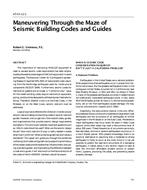Description
The importance of restraining HVAC&R equipment to meet or exceed seismic code requirements has been emphasized by the extensive damage to HVAC&R equipment in recent earthquakes. The National Center for Earthquake Engineering Research reported 40%-80% of replacement costs resulting from the Northridge earthquake were for nonstructural components (NCEER 1994). Furthermore, seismic codes for mechanical systems are no longer a “California only” issue. All the model building codes require mechanical equipment, piping, and duct to be designed to withstand prescribed seismic forces. Therefore, whether a site is on the East Coast, in the Midwest, or on the West Coast, seismic restraint must be addressed. Logical sources to reference for direction in nonstructural seismic restraint design are building codes or seismic restraint guides. However, one can get lost in the maze of codes, guides, and organizations that provide seismic design requirements and details. This article will address important questions such as: Which code should be used? What are the seismic design forces? How much restraint (if any) is really needed in states other than California? What are some guidelines and industry standards? This paper will guide you through the sometimes confusing lot of codes and guidelines by explaining the history of the model codes and the bodies that influence them, discussing available guides, and highlighting the difference between code and a guide. It will also touch on the future direction of the codes of which ASHRAE members should be aware.
Units: I-P
Citation: Symposium Papers, Atlanta, GA, 2001
Product Details
- Published:
- 2001
- Number of Pages:
- 14
- File Size:
- 1 file , 220 KB
- Product Code(s):
- D-7181




